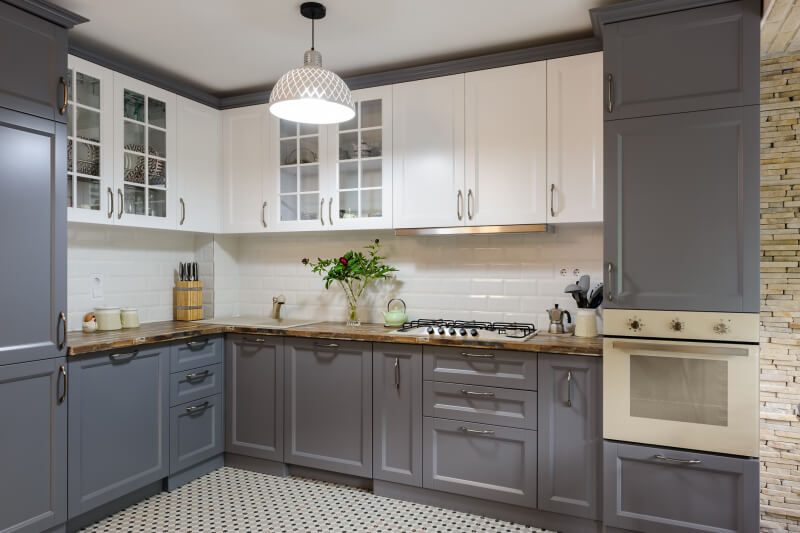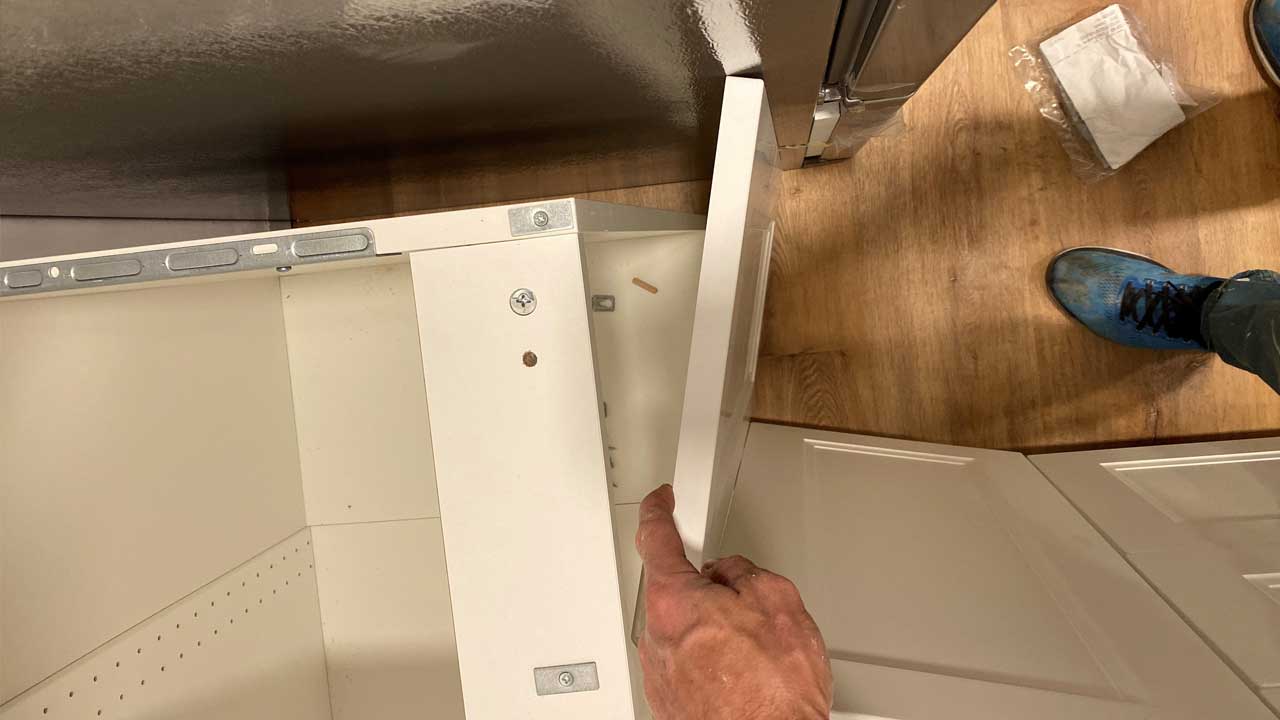Choosing the Right Filler Material

The choice of filler material for your cabinet installation depends on several factors, including the size of the gap, the type of wall material, and the desired aesthetic. Each filler material offers unique advantages and disadvantages.
Comparison of Filler Materials
The following table summarizes the key characteristics of common filler materials:
| Material | Cost | Ease of Application | Durability | Paintability |
|---|---|---|---|---|
| Caulk | Low | Easy | Moderate | Yes |
| Foam | Low | Easy | Moderate | Yes |
| Wood Shims | Moderate | Moderate | High | Yes |
| Molding | High | Moderate to Difficult | High | Yes |
Choosing the Best Filler Material
- For small gaps (less than 1/4 inch): Caulk or foam are suitable options. Caulk provides a smooth, seamless finish and is readily available in various colors. Foam expands to fill gaps and provides insulation, but it can be messy to apply.
- For larger gaps (1/4 inch or more): Wood shims or molding are more effective. Wood shims provide a solid base for attaching cabinets and offer a consistent thickness. Molding adds a decorative element and can hide larger gaps.
- For walls with uneven surfaces: Caulk or foam are preferable for their flexibility in conforming to irregular surfaces.
- For walls with delicate surfaces: Wood shims are a better choice, as they are less likely to damage the wall.
- For a seamless, invisible finish: Caulk is the most suitable option.
- For a more decorative finish: Molding provides a visually appealing solution.
Preparing the Area

Before applying filler, it’s crucial to ensure the surfaces are clean, smooth, and properly prepared for optimal adhesion. This step sets the stage for a seamless and long-lasting result.
Cleaning and Sanding, How to install filler between cabinet and wall
Thorough cleaning removes dust, debris, and any residue that might interfere with the filler’s bond. This is especially important if the cabinet or wall has been painted or sealed.
- Use a damp cloth and mild detergent to wipe down both the cabinet and wall surfaces.
- Allow the surfaces to dry completely before proceeding.
- If there are any imperfections or unevenness, use sandpaper to smooth them out. This will create a uniform surface for the filler to adhere to.
- For stubborn dirt or grease, consider using a specialized cleaner suitable for the materials involved.
Priming the Surfaces
Priming enhances the filler’s adhesion and provides a uniform base for painting or staining.
- Apply a primer specifically designed for the filler material and the surface you’re working with.
- Use a brush or roller to apply a thin, even coat of primer.
- Allow the primer to dry completely before proceeding to the next step.
Measuring the Gap
Accurate measurement is essential for determining the amount of filler needed and ensuring a perfect fit.
- Use a measuring tape to determine the width and depth of the gap between the cabinet and the wall.
- Measure multiple points along the gap to account for any variations in size.
- Note down the measurements for easy reference.
Installing the Filler: How To Install Filler Between Cabinet And Wall

Once you have chosen the appropriate filler material and prepared the area, you can begin installing the filler. The process will vary depending on the type of filler you have chosen.
Caulk
Caulk is a flexible sealant that is often used to fill small gaps and cracks. It is available in a variety of colors to match your cabinets and walls.
To apply caulk, follow these steps:
- Cut the tip of the caulk tube at a 45-degree angle to create a small opening.
- Insert the caulk tube into a caulk gun.
- Apply a bead of caulk along the gap between the cabinet and the wall.
- Use a damp finger or a caulk tool to smooth the caulk and remove any excess.
- Allow the caulk to dry completely before painting or staining.
Tip: When applying caulk, use a steady hand and apply even pressure to ensure a smooth and even bead.
Foam
Foam is a versatile filler that expands to fill gaps and cracks. It is available in both spray and expanding foam cans.
To apply foam, follow these steps:
- Shake the foam can vigorously for at least 30 seconds.
- Hold the can upside down and apply the foam to the gap between the cabinet and the wall.
- Allow the foam to expand and cure completely.
- Trim any excess foam with a sharp knife or utility knife.
Tip: When using expanding foam, apply it in small increments to avoid overfilling the gap. Allow each increment to cure before applying more foam.
Wood Shims
Wood shims are thin pieces of wood that can be used to fill gaps and provide support. They are available in various sizes and thicknesses.
To apply wood shims, follow these steps:
- Cut the shims to the desired length.
- Insert the shims into the gap between the cabinet and the wall.
- Use a hammer or mallet to tap the shims into place.
- Ensure that the shims are flush with the wall and cabinet.
- Secure the shims with wood glue or construction adhesive.
Tip: When using wood shims, use a level to ensure that the cabinet is plumb and level before securing the shims.
Molding
Molding is a decorative trim that can be used to cover gaps and add a finished look to your cabinets. It is available in various styles, materials, and finishes.
To apply molding, follow these steps:
- Measure the gap between the cabinet and the wall.
- Cut the molding to the desired length.
- Apply wood glue or construction adhesive to the back of the molding.
- Press the molding into place against the cabinet and wall.
- Use a nail gun or hammer and nails to secure the molding in place.
- Finish the molding by painting or staining it to match your cabinets and walls.
Tip: When applying molding, use a level to ensure that the molding is straight and even.
How to install filler between cabinet and wall – Installing filler between a cabinet and wall can create a clean and polished look, especially in a kitchen with a beautiful color scheme like kitchen with blue walls and white cabinets. The filler helps to bridge the gap, preventing awkward spaces and creating a seamless flow.
Remember to measure carefully and use appropriate tools to ensure a precise fit.
Installing filler between a cabinet and wall is a common task in kitchen renovations, ensuring a clean and professional finish. If you’re looking to maximize storage space, consider incorporating large wall cabinets for your kitchen. These cabinets offer ample storage and can be seamlessly integrated with filler pieces, providing a cohesive and functional design.
Once you’ve decided on your cabinet configuration, installing filler becomes a simple step to complete the aesthetic appeal of your kitchen.